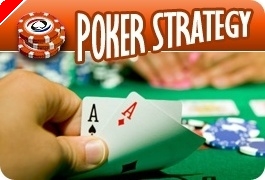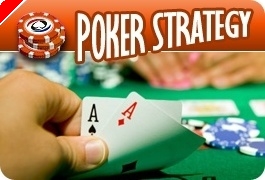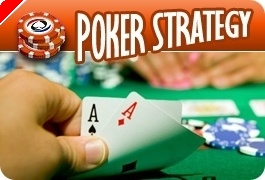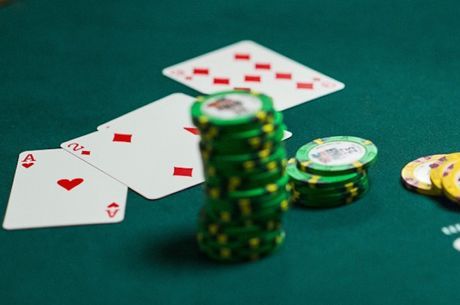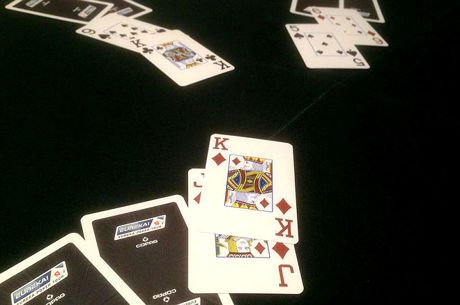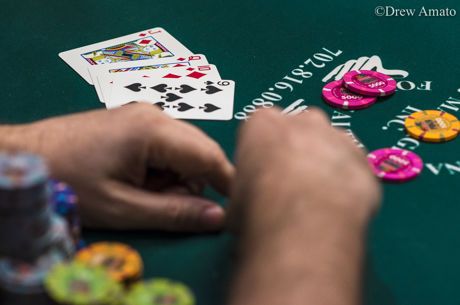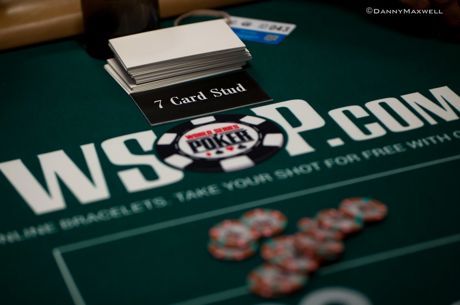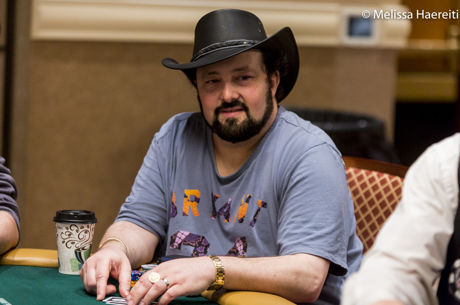Stud Poker Strategy: Drawing and Not Drawing in Stud

A stud player often has to decide whether to draw a card or fold to a bet. This decision is especially important on fifth street when the bets double. I had an interesting hand in a $10/20 stud game at Foxwoods where I had a tough decision to make. Let me share it with you, as I'm interested if you agree with my analysis and decision. This gets somewhat complicated, so put on your seat belt.
I started with (10♣A♣) 8♣. A king, two to my right, completed the bet to $10. A player folded. I called with my three-flush headed by an ace. One other player, with a queen, called as well. No clubs had been folded. One ace had been folded. No kings or queens had been folded. Three of us saw fourth street.
On fourth street I saw, going around to my left:
Q♠7♦
K♠9♠
I was dealt a second ten and had: (10♣A♣) 8♣10♠.
The player with the king was fairly straightforward. I figured he probably had a pair of kings — though there was some chance that he might raise as a semi-bluff on third with only a three-flush. If that was the case he would now have a four-flush headed by the king. I presumed the queen to have either a pair of queens or a pocket pair.
The king was high and bet $20. I called and the queen folded.
On fifth street my opponent's board looked like this:
K♠9♠A♠
I was dealt a suited queen and had: (10♣ A♣) 8♣ 10♠ Q♣.
The king bet $40. I had to either draw another card or fold.
What do you think I should have done?
Think about it for a few minutes if you'd like, then read below.
I had drawn a card on fourth street with the hope of improving – either to aces up, trip tens, or a four-flush. Each hand would have put me in the lead, in my off-the-cuff estimation. So I had improved in one of the directions I was hoping for. My clubs were still completely live. And though an ace had fallen elsewhere, seriously diminishing my chances of hitting aces up, – my chances for a flush had improved significantly.
When your hand improves on fifth street in a direction you are hoping for you are strongly tempted to draw another card. You got what you wanted. In this instance, with my suit completely live, my chances of getting a flush by the river improving to better than 2:1 — so I was tempted to draw another card – especially since there had been a third player in who had enriched the pot with his third-street call. I also still had one shot at aces up and two shots for trip tens.
Still, I had my doubts about whether a draw was justified. Though I had greatly improved my chances for a flush with my fifth-street card, my opponent might have hit a flush that I couldn't beat – meaning that I might be, essentially, drawing dead (I could still win by hitting a runner-runner full house).
It came down to a close decision. I figured, in the final analysis, that the chances were just too great that my opponent was ahead of me to justify a further draw for the double bet. And so I folded.
What do you think in your gut? Would you have folded or called? Might you have raised? (That never occurred to me – but I'm open to any suggestions).
With the luxury of time and computer analysis, I have a better idea of whether I made the right decision. Let me share my analysis with you. In the process I'll be giving you a way of figuring out whether calls or folds are justified when you have two variables – as did I.
The two variables are these: the likelihood of my read being correct and the likelihood that the hand I put him on would win against my hand.
On the one hand, I had to figure out how my likely hand stacked up against my opponent's likely hand if we played them to the river. This can be determined by using a site such as twodimes.net, which pits hands against each other for 500,000 deals and shows the percentage of the time that one hand wins over the others. These are expressed as winning and losing percentages.
But that's not enough to figure out how likely I was to win or lose. I also had to estimate the chances that my read was correct.
Players do this instinctively on the river all the time – to determine whether to call what may be a bluff. You compare the pot odds you're getting to the possibility that your opponent is bluffing to determine whether a call makes sense. For example, if the pot is $1,000, the call is for $100 and you think there's more than a 10% chance that your opponent is bluffing with a hand you can beat, then a call is in order.
In this case you have to do that guesswork on fifth street. Neither hand is complete. And so you must then multiply the likelihood of your read by the percent of the time the hand you put him on will beat your hand. And then you must also perform that same equation for the hand, or hands, he might have if your read is incorrect – and then add up the results.
Let me share with you the method I use for problems such as these and then I'll show you the arithmetic I did for this hand. See if you agree with my analysis and my results.
First, I determine what hands I think my opponents may have. Then I assign each of these possible hands a percentage of likelihood. Then I figure out what percentage of the time each of those hands will beat the hand I have – when the hand progresses to the river. Then I add up those numbers to determine his total chance of beating me on the river.
In the simplest example, you are trying to figure out whether your opponent has Hand A or Hand B, where Hand A will always win and Hand B will never win. You are on the fence about which hand he might have. That means, if you assign a number to your estimation, that you give your opponent a 50/50 chance of having a hand that will beat you 100% of the time and a 50/50 chance of having a hand that will never beat you. 50% of the time then, when you are correct in your assessment, you will lose; and 50% of the time, when you are incorrect in your assessment, you will win. That gives you a 50% chance of winning the hand.
If, on the other hand, you are 90% sure that you are correct in your read, and his likely hand will be the winner 100% of the time, then you have a 90% chance of losing and only a 10% chance of winning.
There are few hands your opponent can have on fifth street that will beat you 100% of the time. If, for example, your opponent has a made flush against your pair, your opponent is about a 95% favorite to win. If you have two pair against his made flush he's about 85% likely to win. So the math gets a little trickier – though it's still fairly simple.
So break down the steps. What if you are 90% sure he has a hand that will beat you on the river 60% of the time? You're not completely certain of your read, but you're pretty sure of it. In that case you multiply the 90% by the 60% and get 48%. You then need to look at the other 10% of the time as well. If he will beat you with that hand 20% of the time then you have a 2% chance of losing with the hand you don't think he has. You must then add up those possibilities. You're 90% sure he'll win 60% of the time and 10% sure he'll win 20% of the time. The addition of those possibilities is 48% plus 2% — for a 50% chance that you'll win the pot.
Of course it's never as easy as that. How do you really put a numeric figure on how sure you are of your read? But you have to make that estimate as best you can, just as you would do on the river when deciding whether to call what might be a bluff.
In this instance, on fifth street, you are performing a dual variable equation – first estimating how sure you are of your read and then figuring out how far ahead or behind you are for each possible hand.
In this instance, given what I knew about him as a player and his betting action, I was about 80% sure that he had the pair of kings and about 20% sure that he had the made flush. I now know that if he had the pair of kings he was about a 60% favorite to win, meaning that if the hand went to the river he'd win about 60% of the time. So the product of my read and his hand's relative strength gave him a 48% chance of winning the hand by holding a pair of kings on fifth street. I also had to figure out what the possibility was that he would win with the other hand he might have had – a flush on fifth street. Though I only gave him a 20% chance of having that flush, it was a 95% likelihood that if he had that hand on fifth street that he'd win the hand on the river. The product of a 95% likelihood of winning with a 20% chance that he had the hand is 19%. To determine how far I figured to be behind, after taking into consideration each of the possible hand he had, I add together the two products. 48% and 19% equals a 67% chance of losing. Expressed in simple terms, it is about 2-to-1 against me winning the hand.
With that analysis, and assuming my numeric estimate of my reads is correct, it seems fairly clear to me that I made the right decision by folding. It did not make sense for me to draw a card on fifth street if I only had a 33% chance of winning the hand on the river.
I've never seen this analysis elsewhere, though I suppose other players do it all the time. I'm interested in what you, as a reader, think of this. Let me know.

